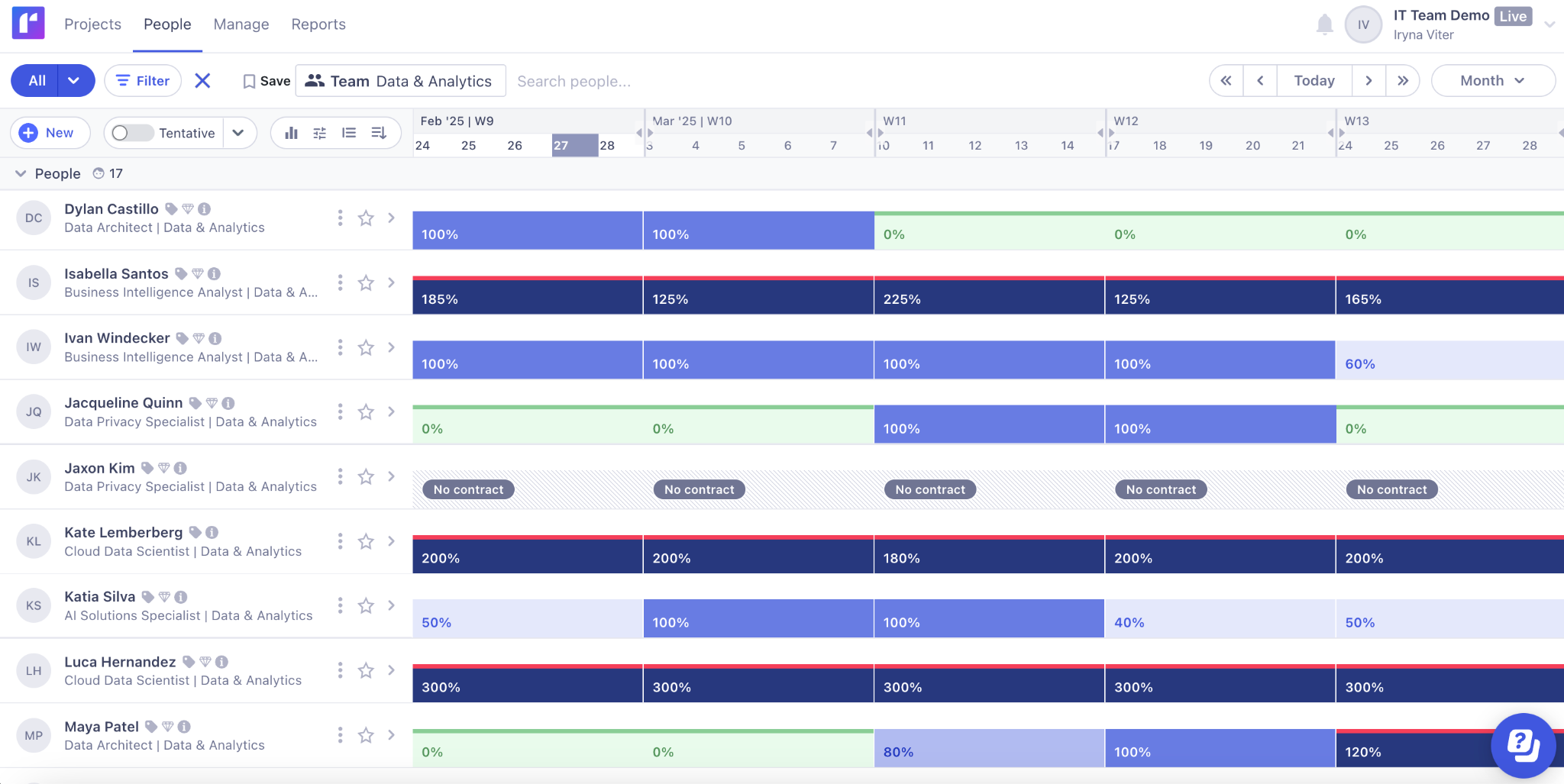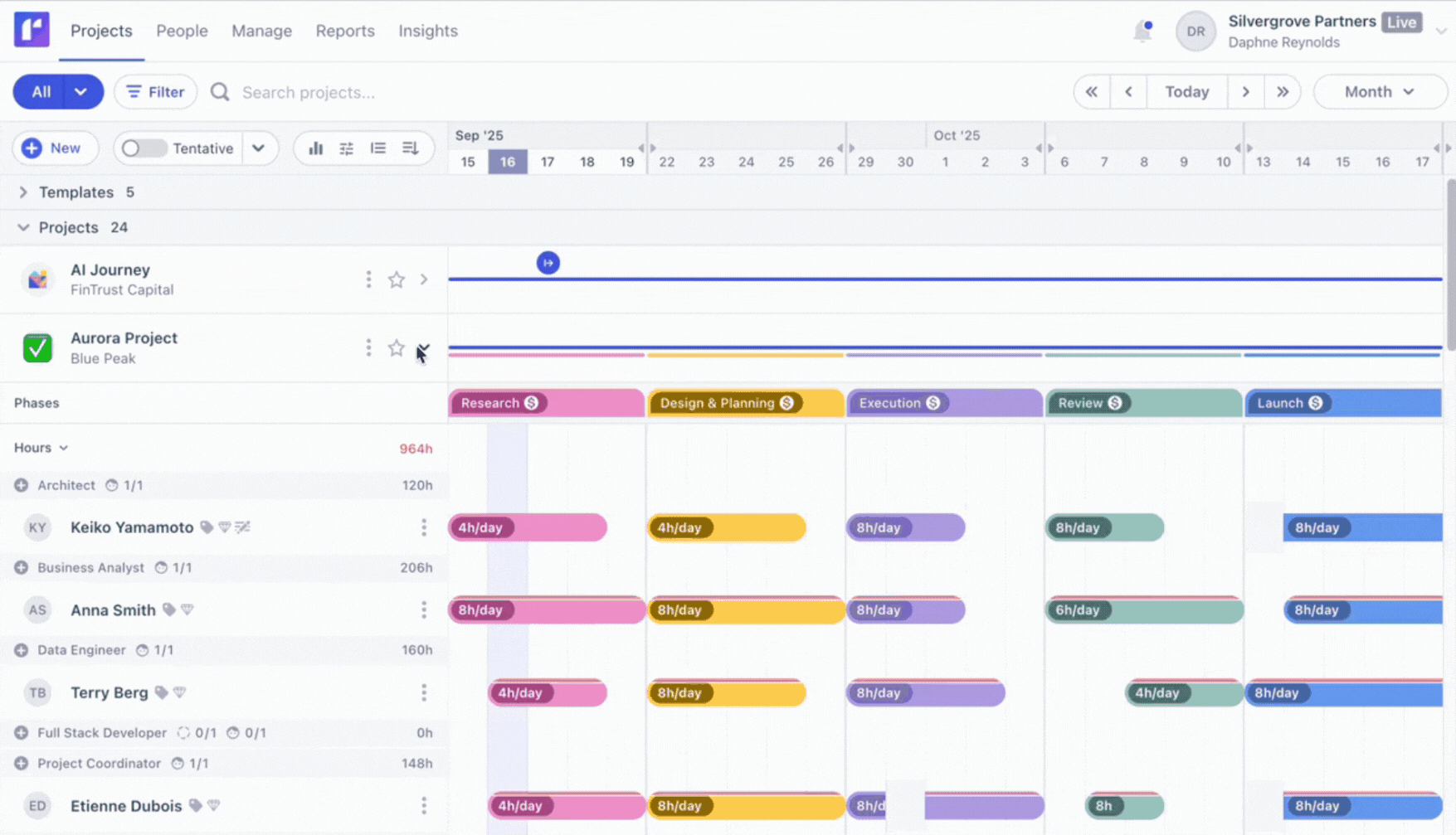All organizations have resources to manage; you need a good process to do it well. Let's walk through the essential stages of resource planning.

Resource planning isn’t something only large or mature organizations need – everyone does it in some form or another.
What sets businesses apart is their process: whether it’s intentional, visible, and repeatable, or reactive and scattered across inboxes, spreadsheets, and people’s heads.
And in practice, reactive planning almost always costs more in stress, missed revenue, and burnt-out teams. Yet over half of teams in our State of Resource Management report say they’re still planning reactively.
If you’re looking to improve how you allocate people to projects, plan time more effectively, or increase your company’s project success rates, keep reading. In this article, we're breaking down the five steps of effective resource planning.
Resource planning is about matching the right people with the right skills to the right projects at the right time.
In practice, it means allocating people to project work according to their availability, capacity, skills, and cost, so you can deliver profitable projects on time and on budget.
.png)
At its core, resource planning isn’t about filling slots on a project plan – it’s about using people’s time thoughtfully, sustainably, and profitably.
And when you’re juggling multiple projects, this challenge compounds quickly.
Resource planning matters because it helps you be more intentional about how you spend your people’s time, especially when demand is high, skills are scarce, and priorities keep shifting.
Dive deeper ➡️ What is Resource Planning? The Beginner's Guide
Resource planning works best when it’s treated as a process, not a one-time thing.
As priorities shift and new work appears, teams need a consistent way to make resourcing decisions without burning people out or relying on guesswork.
So what does an effective resource planning process look like in practice? The resource planning process typically includes five key steps, from establishing a planning baseline through to ongoing monitoring and improvement.
Let’s walk through each step, starting with the groundwork that makes confident delivery decisions – and better outcomes for clients and teams – possible.
Before you think about priorities, projects, or assignments, you need to make sure you’re planning with information you can trust.
Resource planning breaks down fast when timelines are outdated, availability isn’t accurate, or skills data is incomplete. That’s the classic “garbage in, garbage out” problem – and no amount of careful planning can fix it later.
In fact, we found that only half of professionals trust their resource management data, with 58% citing inconsistent inputs as an issue.

This stage is about agreeing on the basics:
Your data doesn’t need to be perfect. But it does need to be consistent and trustworthy. When it isn’t, it’s usually people who feel the impact first – through last-minute changes, overloaded schedules, and constant re-planning.
Get started by checking our guide on how to improve resource data management 📊
Once you have a solid baseline, you can step back and look at the bigger picture. If you’re uncertain about how the future looks, you’re not alone.
That uncertainty is the norm, not the exception. According to our research, 61% of teams struggle to forecast future needs.
This stage is about understanding what work is coming up, what matters most to the business, and what resource constraints you’re working within. Many teams skip this step and jump straight into scheduling – and that’s where most resourcing problems begin.
At this point, you should be reviewing your project pipeline and asking:
In practice, teams often plan at multiple horizons at once – short-term for delivery stability, mid-term for pipeline confidence, and longer-term to guide hiring and capability development.
Learn more: A Guide to Long-Term Resource Planning: Why, When & How
Now you’ve noted the upcoming and planned projects in the pipeline, the next step is understanding what each project actually needs to succeed.
This involves working closely with project managers, delivery leads, and other stakeholders to understand the project’s scope, objectives, timelines, and expectations.
Beginning the resource planning process well in advance of project kick-off means you have adequate time to assess priorities and strategically match resources to future projects.
Ask questions like:
It’s also important to think beyond roles. Many projects will require specialized skills or advanced experience levels, while others will benefit from a specific team member’s involvement due to their knowledge of the client. This helps determine whether work feels manageable or overwhelming for the people doing it.
Remember to build buffers into your project schedule. If you don’t leave a little wiggle room to accommodate the unexpected, one small schedule slip can cause major disruptions.
Learn more ➡️ Best Practices for Requirements Gathering in Project Management
With priorities and requirements clear, it’s time to allocate people to the work.
This is where the real resource planning magic happens; as a resource manager, you’re responsible for identifying which team members are best equipped to complete the project work.
Yet, it’s also where friction can appear. Allocation decisions aren’t just about matching available resources to scheduled projects, but utilizing skills in the best way, being realistic about people’s time, and structuring plans to support project progress.
Start by evaluating your available people against the work ahead:
Equipped with a detailed understanding of project needs and timeframes, you can begin to identify suitable resources for the work. This is important to support healthy resource utilization while ensuring project managers have access to the right mix of skills and experience.
In more advanced practice, you may also consider the interests and career ambitions of resources, to match them to projects that will engage and develop them. But that’s next-level thinking. Let’s nail the basics first.

Having identified your dream team, you need to secure them. At this point, it’s important to be clear about ownership. Whether resourcing decisions sit with a dedicated resource manager, delivery lead, or shared forum, ambiguity here is one of the fastest ways plans break down.
In some organizations, project managers can assign people directly. In others, resources are requested through a central process or resource manager.
Finally, those commitments need to be scheduled and made visible. Assignments should be reflected in a shared plan – ideally via a centralized resource planning tool – so everyone understands who is booked on what, and when.
When bookings live only in someone’s head or inbox, plans unravel quickly and trust erodes.
Resource planning doesn’t stop once work begins. This final stage is about monitoring reality as it unfolds and adjusting early.
As projects move forward, things will change – scope shifts, priorities move, people take time off, and new work appears. That’s why this stage is about monitoring what’s happening in real time and learning from what’s already been delivered. When plans aren’t updated as changes happen, people often absorb the impact through longer hours, constant context switching, and last-minute rework.
Ongoing monitoring helps teams spot issues and resource conflicts early, while there’s still time to respond. This means keeping a close eye on:
Catching these signals early makes it easier to adjust plans before small issues turn into burnout or delivery risk. What’s more, tools that update capacity and utilization in real time make this kind of early intervention far easier than manual reporting ever could.
The work doesn’t end when a project is delivered. This stage is also about stepping back and evaluating how accurate your original plan really was, by comparing what you expected to happen with what actually happened.
Over time, this helps teams understand:
These insights should feed directly into future plans, helping teams plan more realistically and reduce the need for reactive changes.

Now that you understand how to implement the five steps of resource planning, let’s look at a few best practices that can significantly improve delivery outcomes and day-to-day decision-making.
For more on the fundamentals of resource management, check out our webinar episode with RMCP leader Martha Arias-Webster.
Measurement begins and ends with metrics. Useful signals to track include:
Keep reading ➡️ Why Resource Utilization Should Be Part of Your KPIs
But this becomes impossible when you don't have access to accurate real-time data on how your resources' time has been used. That's why you need a resource management tool capable of capturing project information, usage data, and more.
If you want to succeed in resource planning, you need to get your company’s leadership fully onside.
That means helping leaders understand why resource planning matters beyond scheduling – and how it supports strategic goals like predictable delivery, sustainable growth, and healthier workloads.
Long story short, good resource planning is a win-win!
Unless you’re very fortunate, you have limited capacity available – which makes prioritization unavoidable.
When it comes to resource planning for multiple projects, a few practices help project managers and resource managers work more effectively together:
Once you’ve identified which projects best serve the organization’s strategy, you can prioritize their importance, and allocate resources accordingly – matching high-priority projects with the right talent. And, perhaps just as importantly, you can push back on projects that don’t justify the trade-offs.
Successful resource planning isn’t conducted in isolation.
One way to involve your project managers in the process is to host regular resource planning meetings.
This gives everyone an opportunity to communicate their resourcing needs or raise concerns, allowing changes to be made well ahead of time. This will help mitigate risks and prevent resource conflicts.
For example, if two project managers request the same software engineer over the same period, you can take the time to assess each project’s needs and make a strategic decision on which project to assign them to.
We recommend putting a regular time in the diary to review resources so that resource management remains at the top of everyone’s priority list. This is especially beneficial if your organization is large, with more than 50 complex projects running concurrently.
Further reading ➡️ How to Nail a Resource Planning Meeting.
Sure, you can do your resource planning in Excel. But why would you when there are countless alternatives available?
Spreadsheets are incredibly useful when it comes to conducting data analysis, but they’re not designed for resource planning and forecasting. Not only are they overly complex, but they can’t be integrated with your other systems, like planning, time-tracking, and HR tools.
Plus, they’re not flexible enough to offer all the features you need to manage resources successfully – especially compared to the alternatives, like a resource planning tool.
Between spreadsheets, notepads, and emails, there are many ways to complete resource planning activities without purpose-built software – but there are limits to what those approaches can support.
As teams grow and work becomes more complex, these manual methods make it harder to keep information up to date, spot issues early, or adapt plans as things change. That’s where dedicated resource planning software can make a meaningful difference.
If you want to build a more strategic approach to resource planning, dedicated software helps by:
The best resource planning tools are specifically designed to support project-based resource management. They streamline everyday planning tasks like finding and allocating people, keep data in sync across systems, and make it easier to visualize demand, capacity, and potential conflicts before they become problems.

Runn gives resource managers a real-time view of people, projects, and capacity across multiple initiatives. By bringing planning, scheduling, and utilization data into one place, it helps teams move away from spreadsheet-driven guesswork and make more confident, human-centered resourcing decisions.